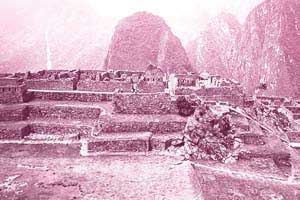




前哥伦布时代 |

|
从哥伦布“发现”新大陆那一刻开始,美洲文明翻开了崭新的一页,欧洲史也为之改写。那么,在哥伦布到来之前的美洲大陆,也即前哥伦布时期是怎样的呢?那里是否居住着土著居民?原住民的文明程度如何?他们过着怎样的生活?现在,就让我们来一探究竟。

|
Reading in a single sitting
|
The specifics of Paleo-Indian migration to and throughout the Americas, including the exact dates and routes traveled, are subject to ongoing research and discussion. The traditional theory has been that these early migrants moved into the Beringia(白令)land bridge between eastern Siberia(西伯利亚)and present-day Alaska(阿拉斯加)around 40, 000-17, 000 years ago, when sea levels were significantly lowered due to the Quaternary glaciation . These people are believed to have followed herds of now-extinct pleistocene megafauna along ice-free corridors that stretched between the Laurentide(劳伦太德冰盖)and Cordilleran(科迪勒拉)ice sheets. Another route proposed is that, either on foot or using primitive boats, they migrated down the Pacific Northwest coast to South America. Evidence of the latter would since have been covered by a sea level rise of hundreds of meters following the last ice age.
archaeologists contend that Paleo-Indians migration out of Beringia (eastern Alaska), ranges somewhere between 40, 000 and 16, 500 years ago. The few agreements achieved to date are the origin from Central Asia, with widespread habitation of the Americas during the end of the last glacial period, or more specifically what is known as the late glacial maximum, around 16, 000-13, 000 years before present.
The Inuit migrated into the Arctic section of North America in another wave of migration, arriving around 1000 CE.Around the same time as the Inuit migrated into North America, Viking(维京)settlers began arriving in Greenland(格陵兰)in 982 and Vinland(文兰)shortly thereafter, establishing a settlement at L' Anse aux Meadows(安斯梅多), near the northernmost tip of Newfoundland. The Viking settlers quickly abandoned Vinland, and disappeared from Greenland by 1500.
The pre-Columbian era incorporates all period subdivisions in the history and prehistory of the Americas before the appearance of significant European influences on the American continents, spanning the time of the original settlement in the Upper Paleolithic(旧石器时代晚期)to European colonization during the Early Modern period.

Pre-Columbian is used especially often in the context of the great indigenous civilizations of the Americas, such as those of Mesoamerica[the Olmec(奥尔梅克人), the Toltec(托尔特克人), the Mixtec(米斯特克人), the Aztec(阿兹特克人), and the Maya(玛雅人)and the Andes(安第斯山脉), Inca(印加人), Moche(莫克人)].
Many pre-Columbian civilizations established characteristics and hallmarks which included heretical or urban settlements, agriculture, civic and monumental architecture, and complex societal hierarchies. Some of these civilizations had long faded by the time of the first permanent European arrivals (late 15 th-early 16th centuries), and are known only through archaeological investigations. Others were contemporary with this period, and are also known from historical accounts of the time. A few, such as the Maya, had their own written records. However, most Europeans of the time viewed such texts as heretical , and much was destroyed in Christian pyres. Only a few hidden documents remain today, leaving modern historians with glimpses of ancient culture and knowledge.
According to both indigenous American and European accounts and documents, American civilizations at the time of European encounter possessed many impressive accomplishments . For instance, the Aztecs built one of the most impressive cities in the world, Tenochtitlan(特诺奇蒂特兰地区), the ancient site of Mexico City, with an estimated population of 200, 000. American civilizations also displayed impressive accomplishments in astronomy and mathematics.
总之,在前哥伦布时代,在广袤的美洲大陆上,美洲印第安人创造了三大文明,它们是位于今天的尤卡坦、危地马拉和伯利兹地区的玛雅文明,位于今天墨西哥地区的阿兹特克文明以及囊括从厄瓜多尔中部至智利中部3000英里地区的印加文明。
他们培育出包括玉米、倭瓜、土豆、胡椒、烟草、棉花和豆类等作物,今天世界上近一半的食物发源于此;发达的天体知识;以太阳金字塔为代表的建筑技术;发达的水利灌溉系统等等。但是,当自给自足、和平宁静的印第安文明遭遇正在野心勃勃四处扩张的欧洲文明时,将是一场灭顶之灾。这一切,就从哥伦布的地理大发现开始。
glaciation 冰川作用
pleistocene 更新世、更新岩世
megafauna 巨型生物
archaeologist 考古学家
glacial 冰的、冰川的、冰河时代的
abandon 抛弃
subdivision 细分
hallmark 印记、标志
heretical 异端的
heretical 永久的
impressive 令人印象深刻的
accomplishment 技艺、成就

|
Key Words in History
|
"Pueblo" is a term used to describe modern (and ancient) communities of Native Americans in the Southwestern United States of America. The first Spanish explorers of the Southwest used this term to describe communities that consisted of apartment-like structures made from stone, adobe mud, and other local material. These structures were usually multi-storied buildings surrounding an open plaza and were occupied by hundreds to thousands of Pueblo People.
The Maya is a Mesoamerican civilization, noted for the only known fully developed written language of the pre-Columbian Americas, as well as for its art, architecture, and mathematical and astronomical systems. Initially established during the Pre-Classic period (2000 BC to 250 AD), according to the Mesoamerican chronology, many Maya cities reached their highest state of development during the Classic period (250 AD to 900 AD), and continued throughout the Post-Classic period until the arrival of the Spanish.
The Maya civilization shares many features with other Mesoamerican civilizations due to the high degree of interaction and cultural diffusion that characterized the region. Advances such as writing, epigraphy, and the calendar did not originate with the Maya; however, their civilization fully developed them. Maya influence can be detected from Honduras, Guatemala, Northern El Salvador and to as far as central Mexico, more than 1000 km (625 miles) from the Maya area. Many outside influences are found in Maya art and architecture, which are thought to result from trade and cultural exchange rather than direct external conquest.
The Inca Empire, or Inka Empire, was the largest empire in pre-Columbian America. The administrative, political and military center of the empire was located in Cusco in modern-day Peru. The Inca civilization arose from the highlands of Peru sometime in the early 13th century. From 1438 to 1533, the Incas used a variety of methods, from conquest to peaceful assimilation, to incorporate a large portion of western South America, centered on the Andean mountain ranges, including large parts of modern Ecuador, Peru, western and south central Bolivia, northwest Argentina, north and north-central Chile, and southern Colombia into a state comparable to the historical empires of the Old World.

The official language of the empire was Quechua, although hundreds of local languages and dialects of Quechua were spoken. The Inca referred to their empire as Tawantinsuyu which can be translated as The Four Regions or The Four United Provinces. There were many local forms of worship, most of them concerning local sacred "Huacas", but the Inca leadership encouraged the worship of Inti-the sun god-and imposed its sovereignty above other cults such as that of Pachamama. The Incas considered their King, the Sapa Inca, to be the "child of the sun."
Cuzco the capital city, was said by the Spanish to be "as fine as any city in Spain". Perhaps the most impressive city of the Incan was not its capital, Cuzco, but the city Machu Picchu. This mountain retreat is built high in the Andes and is sometimes called the "Lost city of the Incas." It was intended as a mountain retreat for the leaders of Incan empire and shows great artistry-the abundant dry stone walls entirely built without mortar and the blocks cut so carefully that one can' t insert a knife-blade between the massive blocks.

|
Background Knowledge
|
美洲大陆的历史当然不是从1492年哥伦布抵达美洲开始的。事实上,美洲文明或许起源于上个冰河世纪,大约15000年到40000年以前。历史学家认为,印第安人的祖先可能在大约2万年前从亚洲渡过白令海峡到达美洲的,或者是通过冰封的海峡陆桥过去的。他们来到美洲并且陆续分散到各地,形成了有自己特色的部落文化。
当意大利航海家哥伦布航行至美洲时,误以为所到之处为印度,因此将此地的土著居民称作“Indians”。后来,虽然发现他错了,但习惯称法已经普及了,所以英语和其他欧洲语言中称印第安人为“西”印度人。在必要时,为了区别,称真正的印度人为“东”印度人。汉语翻译时直接把“西印度人”这个单词翻译成“印第安人”或“印地安人”。
当时的印第安原住民没有自己的文字,却有着丰富的口头文学,但随着原住民人口的锐减,这些口头文学也就难觅踪影了。从总体上讲,印第安文明相对于其他大陆上的文明来说,数千年的孤立隔绝使其演进的速度非常缓慢。虽然他们在培育植物方面成就辉煌,但除了仅能最低限度地保证人们的食物需求外,没有发展出耕作技术。他们仅有石制、木制、骨制的工具,不能熔炼矿石,更没有刀剑和火器。而在制度方面,美洲印第安人还停留在氏族部落阶段。各种各样的部落彼此间存在着巨大的差别,从语言一直到崇拜对象。比如,目前仍然存在的美洲原住民语言约有350种,分属十几个语系,至今没有公认的语言分类。
由于美洲原住民没有统一的语言,没有文字,再加上原住民人口在新大陆被发现之后锐减90%,因此,目前残存的古代文明材料已经不多。想要更深入地了解这段历史,我们只好寄希望于古代印第安文化遗址的大力发掘。